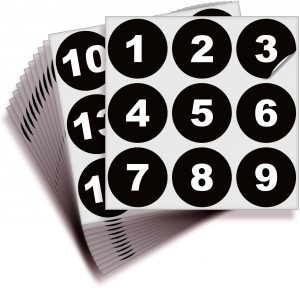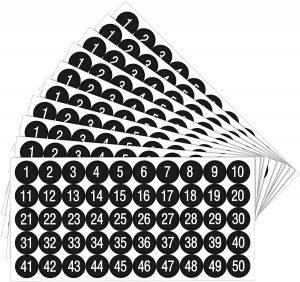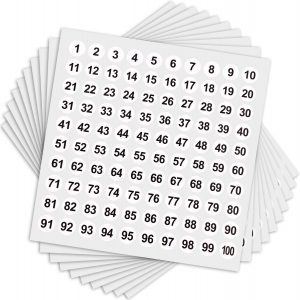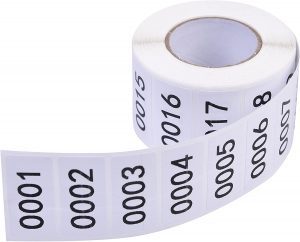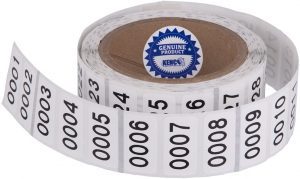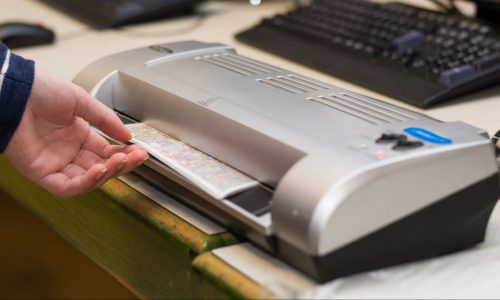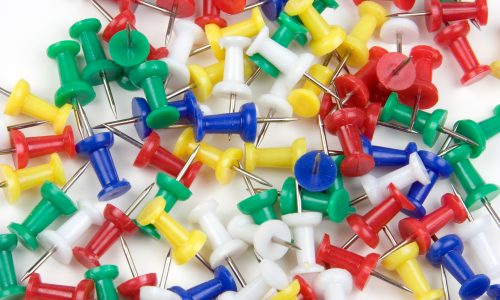The Best Number Labels
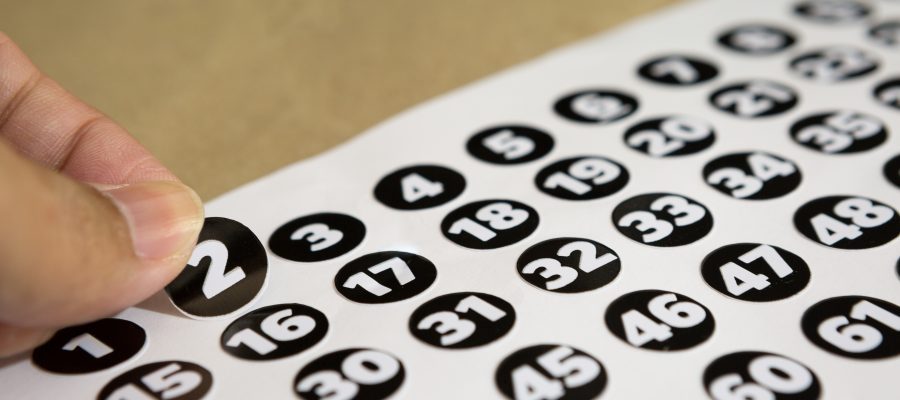
Our Review Process
Don't Waste Your Money is focused on helping you make the best purchasing decision. Our team of experts spends hundreds of hours analyzing, testing, and researching products so you don't have to. Learn more.
Our Picks For The Top Number Labels
Available in multiple colors, this numbered sticker set can be used for a variety of purposes. You’ll get one set of numbers from one to 100, each featuring bold text on a solid background. The material is high-performance-grade vinyl that lasts for years after applied to a surface.
Durable OptionMade from high-performance vinyl, these number labels offer both water and weather resistance, as well as resistance to ultraviolet damage.
This set includes 10 sheets of round vinyl stickers numbered one to 50, with each sticker measuring 1 inch. You can choose from three different colors, including black, and each sticker easily peels off. The vinyl used is waterproof and weatherproof and adheres firmly to the surface once applied.
Customizable UsesTen sheets of stickers, each numbered one to 50, make this a set you can customize to your needs.
Measuring less than a 1/2 inch each, these numbered stickers are a smaller option, ideal for labeling objects like jewelry and cosmetics. Each set includes 100 sheets, each including stickers numbered one to 100, for 10,000 stickers total. These stickers feature strong glue that ensure they adhere firmly to surfaces.
Simple DesignBlack text on a white background gives these small round stickers versatility.
With numbering in a black font that's large and bold, these labels are great for numbering items for inventory or even for daily use. The stickers are numbered from 0001 to 1,000, with each label measuring 1 1/2 inches. The stickers are coated for extra protection.
Super ConvenientEasily number inventory items with this set, which is sold in a convenient roll format.
Buying Guide
As more Americans than ever resign from their jobs in what’s become known as the Great Resignation, it appears they are working to become their own bosses as the number of people starting their own businesses has climbed. In fact, in 2021, the number of new business filings was up more than 400,000 from 2019.
For many, the ease of being able to operate a business from home is a big draw. But there are some challenges home-based businesses face, including the ability to manage and track inventory. There are plenty of tools available to help, but the fulfillment centers some businesses use may be too pricey, especially at first.
Luckily, managing your own inventory just requires getting all your resources lined up. You’ll need a good app for tracking, but the products themselves will need identifiers. This is especially important if you’re selling multiples of each item. Many manufacturers use stock-keeping units, which is a scannable barcode, but this can be burdensome for sellers who are just starting out. A simple numbering system can be a great way to start.
If you opt for number labels, you’ll get a page of labels, typically numbered sequentially, and a backing that lets it stick to a variety of surfaces. These can be used for a wide range of purposes, but inventory management has become one of the most popular. For inventory purposes, you’ll need labels that can affix to your products, so for smaller or curved items, smaller labels will likely be better.
Some of the other purposes for number labels include numbering boxes, lab samples and file cabinets. They can often be seen in classrooms and schools to number items like cubbyholes, lockers and supplies. It can be a simple but effective way to assign belongings to large groups of people in any environment.
What to Look For
- It can be tough to strike a balance between a label that will stay in place and easy removal. Some labels will hold up over the months and years, but when it’s time to remove them, you end up with a mess. A plastic scraper and some acetone can remove paper and glue residue, but acetone isn’t safe for all surfaces. Oil or mild soap can be a safer alternative on some surfaces.
- As valuable as durable adhesive can be, your labels won’t be of much help if the print fades or is easily erased by water or other products. Some are coated on the front to protect the print.
- Number labels come in a variety of colors, including colored text on a white background and white text on a colored background. Those colors can vary from neutral black to vivid reds, blues and greens.
- Look at the typeface on the label you choose. Some are bolder than others, making them easier to read, particularly from a distance.
- The size of each label can vary substantially. Pay close attention to those measurements because if you’re only seeing a photo of the labels, the pictured size can be deceiving.
- Numbering differs between label sets. Some are numbered only from one to 50, while others go to 100 or 1,000. Some repeat one through 50 or 100 on multiple pages, so if you need a numbering system that goes sequentially beyond that first set, you might have to shop around. For hundreds or thousands of labels, you’ll need a set that’s sold in rolls.
- If your stickers will be exposed to water or weather conditions, consider buying a set that has protective coating to keep the paper of the label safe under those conditions.
- Consider where you’ll store your labels if you keep multiples on hand. Each label sheet has specific measurements. You’ll need a place to keep them safe and protected between uses.
More to Explore
The internet has changed the face of the retail industry forever. Consumers can sell items directly from home, merely needing to collect funds, package items up and put them in the mail. But e-commerce goes back farther than many people realize. The first online sales transaction took place in 1979.
English entrepreneur Michael Aldrich is known for the invention. He managed to connect a television set to a transaction processing computer using a telephone line. His goal was to find a way to open a business to an outside device for information processing—in other words, using a connected computer to process a sale. But he also wanted to open closed business systems to communications for e-messaging purposes. All of it was a precursor to the way businesses commonly operate today.

